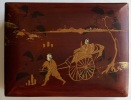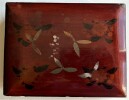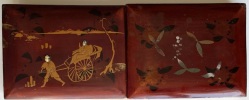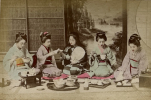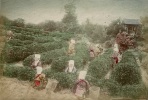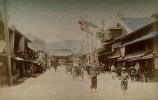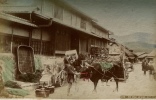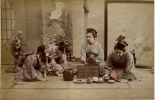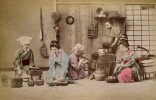[JAPON - YOKOHAMA - SHASHIN - Album laqué japonanais de 50 photographies colorisées à la main/JAPAN - YOKOHAMA - Japanese lacquer album of 50 hand-coloured photographs]
S. L. N. D. [Japon, époque Meiji, circa 1880]. 1880 1 vol in-8 oblong ( 150 x 193 mm.) comportant 50 tirages albuminés colorisés à la main (90 x 138 mm) contrecollés sur feuilles de carton montées en acordéon. (rousseurs dans les marges, photos en bel état). Reliure orientale en accordéon, plats de bois laqué rouge ornés de peintures figurant sur le premier plat une scène de vie dans un paysage avec deux personnages aux visages en os sculpté, et des fleurs pour le second.
Reference : 5641
Superbe petit album japonais « Yokohama-shashin » contenant cinquante tirages albuminées mis en couleur à la main représentant des vues des habitants, des villes et des paysages du japon au début de lère Meiji. Ce type d'album souvenir apparaît au Japon dans la seconde moitié du XIXe siècle. C'est sous l'ère Meiji (1868-1912) que le pays s'ouvre à l'Occident. Beaucoup détrangers viennent au Japon et les Japonais peuvent voyager au sein du Japon sans enfreindre les lois. Yokohama est alors un endroit privilégié pour rencontrer à la fois des étrangers et des Japonais et les « Yokohama-shashin » ont un grand succès auprès des voyageurs. Leurs deux principales caractéristiques sont : des photographies réunies dans un album bien décoré, et des photographies coloriées à la main. Les artistes japonais, reconnus pour leur maîtrise de l'estampe, souvent coloriée à la main, découvrent alors la perspective occidentale. Le genre de l'ukiyo-e, littéralement « image du monde flottant » ou « image du temps qui passe » - ou nishiki-e lorsque ces images sont coloriées , qui règne en maître du XVIIe au XIXe siècle, est alors détrôné par la photographie. Les premières représentations photographiques du Japon sont réalisées par des Occidentaux, dont Felice Beato qui s'installe à Yokohama en 1863, suivi peu après par le baron Raimund von Stillfried et Adolfo Farsari. Le peintre Charles Wirgman (1832-1891) est sans doute le premier à tenter d'apposer des rehauts de couleurs sur les photographies de Felice Beato. Le succès de ces images peintes amène les coloristes japonais à travailler directement dans les ateliers de photographie et rapidement, les Japonais, élèves de ces maîtres, reprennent à leur tour cette technique et ouvrent de nouveaux studios. Le plus célèbre et talentueux d'entre eux est Kusakabe Kimbei, disciple de Felice Beato dès l'âge de quinze ans. Ces derniers s'inspirent fortement d'une mise en scène traditionnelle issue de l'estampe : représentations de la vie quotidienne (cérémonie du thé, jeunes filles s'adonnant à la musique, dansant ou jouant aux cartes, scènes de repas, nourrice avec un bébé, jeunes femmes sur un pousse-pousse, etc. portraits de geishas, de vieillards, de prêtres shintos et bouddhistes, de samouraïs, combats de sumos, photographiés le plus souvent dans un intérieur de studio. On y trouve également des vues dextérieurs : paysans travaillant dans les rizières au coucher du soleil, jeunes geishas se promenant dans des jardins fleuris ou posant sous des treilles de glycines en fleurs, vues panoramiques du mont Fuji dans la brume... Mais vers la fin du xixe siècle, les cartes postales illustrées, qui sont beaucoup moins chères que les « Yokohama-shashin », deviennent très populaires et sont largement utilisées et de nombreux photographes amateurs émergent qui préfèrent prendre des photos eux-mêmes plutôt que d'acheter d'onéreux « Yokohama-shashin », doù leur rapide déclin. Dans notre exemplaire, comme traditionnellement, les photos sont contrecollées au recto-verso de cartons forts reliés bout à bout et repliés. Les 25 du recto sont en partie légendées en anglais : « Templa at Nikko, Tee Garden, To pile up and out Tee, Fuji from Otometoge, Fujiya Miyanoshita, OHato Nagasaki, Osaka Sumeyosi, Takaboko (Papenberg) Nagasaki, Nagasaki ». Celles du verso sont consacrées aux habitantes du pays : portraits, scènes de vie, de jardin, de maison, cérémonie du thé Il est paré de sa jolie reliure dorigine aux plats de bois laqué rouge ornés de peintures figurant sur le premier plat une scène de vie dans un paysage avec deux personnages aux visages en os sculpté et dun décor floral pour le second. Bel exemple de cet éphémère art traditionnel japonais. 1 vol. 8vo oblong (150 x 193 mm.) with 50 hand-colored albumin prints (90 x 138 mm) mounted on cardboard sheets (foxing in the margins, photos in good condition). Oriental accordion binding, red lacquered wooden boards decorated with paintings depicting on the first board a scene of life in a landscape with two figures with carved bone faces, and flowers for the second. Beautiful small Japanese album "Yokohama-shashin" containing fifty hand-colored albumin prints depicting views of the people, cities and landscapes of Japan in the early Meiji era. This type of souvenir album appeared in Japan in the second half of the 19th century. It is during the Meiji era (1868-1912) that the country opens to the West. Many foreigners came to Japan and Japanese could travel within Japan without breaking the laws. Yokohama is then a privileged place to meet both foreigners and Japanese and the "Yokohama-shashin" have a great success with travelers. Their two main characteristics are: photographs gathered in a well-decorated album, and hand-colored photographs. Japanese artists, known for their mastery of the print, often hand colored, discovered the western perspective. The genre of ukiyo-e, literally "image of the floating world" or "image of passing time" - or nishiki-e when these images are colored -, which reigned supreme from the 17th to the 19th century, was then dethroned by photography. The first photographic representations of Japan were made by Westerners, including Felice Beato who settled in Yokohama in 1863, followed shortly after by Baron Raimund von Stillfried and Adolfo Farsari. The painter Charles Wirgman (1832-1891) was undoubtedly the first to attempt to apply color highlights to Felice Beato's photographs. The success of these painted images led the Japanese colorists to work directly in the photographic studios and quickly, the Japanese, students of these masters, took over this technique and opened new studios. The most famous and talented of them is Kusakabe Kimbei, a disciple of Felice Beato from the age of fifteen. The latter were strongly inspired by a traditional setting from the print: representations of daily life (tea ceremony, young girls playing music, dancing or playing cards, meal scenes, nurse with a baby, young women on a rickshaw, etc.), portraits of geishas, old men, Shinto and Buddhist priests, samurai, sumo wrestling, photographed most often in a studio interior. There are also outdoor views: peasants working in rice fields at sunset, young geishas walking in flower gardens or posing under wisteria vines in bloom, panoramic views of Mount Fuji in the mist... But towards the end of the 19th century, illustrated postcards, which are much cheaper than "Yokohama-shashin", become very popular and are widely used and many amateur photographers emerge who prefer to take pictures themselves rather than buying expensive "Yokohama-shashin", hence their rapid decline. In our copy, as traditionally, the photos are laminated on the front and back of strong cardboards bound end to end and folded. The 25 on the front are partly captioned in English: "Templa at Nikko, Tee Garden, To pile up and out Tee, Fuji from Otometoge, Fujiya Miyanoshita, O'Hato Nagasaki, Osaka Sumeyosi, Takaboko (Papenberg) Nagasaki, Nagasaki". Those on the back are dedicated to the country's inhabitants: portraits, scenes of life, garden, house, tea ceremony... It is adorned with its beautiful original binding with red lacquered wooden boards decorated with paintings showing on the first board a scene of life in a landscape with two characters with faces in carved bone and a floral decoration for the second. Nice example of this traditional Japanese art.
Bookseller's contact details
J-F Letenneur Livres Rares
M. Jean-François Letenneur
11 bd du tertre Gondan
35800 Saint Briac sur Mer
France
librairie@jfletenneurlivresrares.fr
06 81 35 73 35
 Write to the booksellers
Write to the booksellers